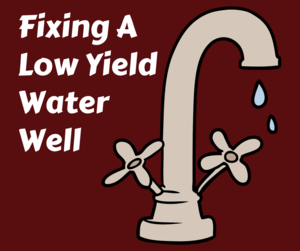CALL TODAY 1-800-441-6281
CALL TODAY 1-800-441-6281

Water Well Rehabilitating Methods
If you’ve noticed that your well doesn’t seem to be producing water like it once did, that the faucets spit and sputter when you turn on the water, or your well occasionally runs dry, there are a number of fixes you can try to make your well more productive without having to bear the major expense of drilling an entirely new well.
Water well rehabilitation is the process of opening up the cracks and crevices where water flows from the ground into the well casing or pipe. Sometimes these openings get clogged with sediment or slime. In other cases, small fissures are blocked or dry up. The solutions can vary from adding chemicals to the well to drilling.
WHAT CAUSES THE FLOW OF WELL WATER TO SLOW?
In areas that are prone to drought during certain times of the year, the culprit for poor well yield is often a drop in the water table. Fortunately, New England doesn’t often experience long periods of drought and has many places where the water table or aquifer has enough water to adequately supply a home.
The cause could also be blocked fissures that supply your well, clogged holes in the well’s casing or crusting around well screens at the base of the casing. If water can’t flow through the screen or casing, homeowners will quickly see a drop in water production. This crusting and clogging could be caused by, silt, clay or sand. It is also common for calcium carbonate, iron bacteria, or even a slimy combination of sediment and deposits to clog up the works in a well.
HOW TO FIX LOW WATER YIELD?
Whether it’s clogging or poorly functioning bedrock fissures behind your water well issues, injecting the lower part of your well with high-pressured water may increase your well’s yield and lifespan. High pressure jetting, hydrofracturing and well surging are also procedures in which water is injected into the well at extreme pressure.
High-pressure jetting dislodges debris from the well with an adjustable, multi-head, water-powered jet that lowers into the well and injects water at a high pressure. Water surging clears blockages with repeated water injections and flushing of the well to wash debris away. Hydrofracturing, or hydrofracking, is when water is sent into the well at a very high pressure, removing debris from clogged holes in the casing and within the bedrock fissures through which groundwater flows into the well.
Skillings & Sons prefers hydrofracking because of its high success rate. In fact, we’ve found hydrofracking increases the flow rate in wells 98% of the time.
Iron bacteria and slime may require chemical removal, such as a liquid bacteria acid. If the bacteria problem keeps returning, there are other more aggressive chemicals, such as muriatic acid and hydroxyacetic acid, which contractors can use. Treatment begins with adding chemicals in the well and agitating frequently for up to 72 hours. The chemicals are safe to use, but homeowners will want to test the water after the well has been pumped and flushed.
CAN WELL REHABILITATION HELP?
Water well specialist can do some tests on your well to find the problem before you hire them for a well rehabilitation. Often, the well is shut off for 24 to 48 hours to see if the level of the water table returns to the original level when the well pump isn’t running. If the water does return, rehabilitation will usually work.
If you’d like to learn more about well rehabilitation procedures, contact Skillings & Sons today.

